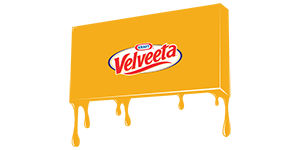Processed cheese is a food product made from normal cheese and sometimes other unfermented dairy ingredients, plus emulsifiers, extra salt, food colorings, or whey. Many flavors, colors, and textures of processed cheese exist. In the United States, the most recognizable variety of processed cheese is sold under the name American cheese, although this name also has other meanings. The Laughing Cow is an example of processed cheese.
Although processed cheese was first invented in 1911 by Walter Gerber of Thun, Switzerland, it was James L. Kraft who first applied for an American patent for his method in 1916. Kraft Foods also created the first commercially available sliced processed cheese, which was introduced in 1950. This form of sliced cheese and its derivatives have become commonplace in the United States, most notably used for cheeseburgers and grilled cheese sandwiches.
Processed cheese has several technical advantages over unprocessed cheese, including extended shelf-life, resistance to separation when cooked, and homogeneity. Its production also enjoys significant economic advantages over traditional cheesemaking processes, most often through the ability to incorporate any of a wide variety of less expensive ingredients.
The use of emulsifiers in processed cheese results in cheese that melts smoothly when cooked. With prolonged heating, unprocessed cheese will separate into a molten protein gel and liquid fat; processed cheese will not separate in this manner. The emulsifiers, typically sodium phosphate, potassium phosphate, tartrate, or citrate, reduce the tendency for tiny fat globules in the cheese to coalesce and pool on the surface of the molten cheese. Because processed cheese does not separate when melted, it is used as an ingredient in a variety of dishes. It is a popular addition to hamburgers, as it does not run off, nor does it change in texture or taste as it is heated.
Processed cheese is often criticized for its possible health effects (associated with chemical preservatives, artificial colors/flavors, and trans-fats), inferior taste, and small range of flavors, which is far narrower than the range for unprocessed cheeses and normally very mild. Processed cheese is sometimes sold in blocks, or spray cans, but more often sold packed in individual slices, sometimes with plastic wrappers or wax paper separating them.
Due to the processing and additives, some softer varieties cannot legally be labeled as ‘cheese’ in many countries, including the United States and United Kingdom, and so are sold as ‘cheese food,’ ‘cheese spread,’ or ‘cheese product,’ depending primarily on the amount of cheese, moisture, and milkfat present in the final product.
The FDA does not maintain a standard for ‘Pasteurized Prepared Cheese Product,’ a designation which particularly appears on many popular Kraft products (as well as some others). Neither does the FDA maintain a standard of identity for ‘Pasteurized Process Cheese Product,’ a designation which appears particularly on many American store- and generic-branded singles. Products labeled as such may therefore use milk protein concentrate (MPC) in the formulation.
The desire to use inexpensive imported MPC is noted as motivation for the introduction of these and similar terms, and for the relabeling of some products. After an FDA Warning Letter protesting Kraft’s use of MPC in late 2002, some varieties of Kraft Singles formerly labeled ‘Pasteurized Process Cheese Food’ became ‘Pasteurized Prepared Cheese Product,’ Velveeta went from ‘Pasteurized Process Cheese Spread’ to ‘Pasteurized Prepared Cheese Product,’ and Easy Cheese went from ‘Pasteurized Process Cheese Spread’ to ‘Pasteurized Cheese Snack.’
The Daily Omnivore
Everything is Interesting




Leave a comment